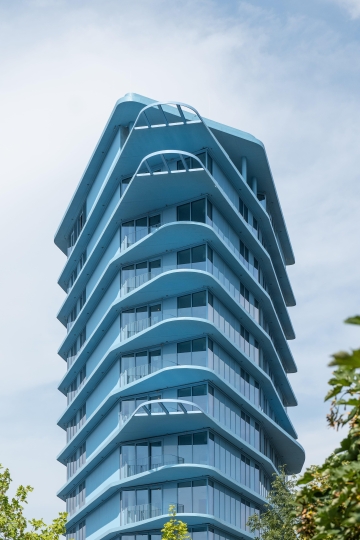The smarter a building, the more sustainable

5 building innovations that will make tomorrow's buildings more sustainable
To make a building more sustainable, we need to make it smarter. Thanks to AI and automation, we can, for example, develop CO2-neutral and cradle-to-cradle building materials and significantly reduce our energy consumption.
This is demonstrated by Living Tomorrow's innovation campus in Vilvoorde, where many of these innovations have already been integrated. Architect Frank Beliën, founder of Living Tomorrow, and Carolyn Beliën, architect, predict the five building innovations that will make our buildings of tomorrow more sustainable.
Buildings consume about 30% of the world's energy and account for almost 40% of annual CO2 emissions, according to a recent United Nations report. Therefore, we must make our structures highly sustainable. And to do so, we need to make them smarter, believes Carolyn Beliën. From the materials we construct them with, to the way we use and eventually demolish or reuse them. Here are 5 innovations that will contribute to more sustainable buildings.
1. CO2-reducing building materials
The (production of the) materials we build with are a major source of CO2 emissions. ‘Materials that store and reuse CO2 instead of emitting it are definitely the future,’ Frank Beliën explains. ‘For the exterior cladding of our innovation campus, for example, we worked with the Carbstone technology from Vandersanden. In the production of these blue boards, CO2 is used as a binder and permanently stored in the product, resulting in much lower CO2 emissions in production. We also used Holcim's Ecopact concrete which, thanks to a combination of innovative cement, mineral components, specific additives, and construction and demolition waste, firmly reduces CO2 emissions in production.’
'Materials that store and reuse CO2 instead of emitting it are the future.'
2. Considering the full Life Cycle of building materials
To be sustainable, it is important to consider the full Life Cycle of materials beyond CO2 reduction. ‘This means thinking about how you will maintain, follow up, and eventually recycle the materials,’ explains Frank Beliën. ‘For our innovation campus, for example, we are working with Schüco's “Internet of Façades” application that gives each façade element its own digital identity including composition, maintenance history, and recycling possibilities. This ensures that materials last longer and can also be properly processed at the end of their useful life. In the future, all this information will be incorporated into real ‘digital twins’ of buildings.’
Carolyn adds: ‘The madaster, also known as a materials passport, will also contribute to this. We think of every building as a library of materials. In this digital library, we describe what raw materials the material is made of and its origin. That way we can make much better-informed decisions about the further reuse of a material.’
3. More flexible design to extend building life cycle
Not only the Life Cycle of materials but also buildings themselves play a role in ultimate sustainability. ‘The more flexible the function of a building, the longer the construction and materials can last and therefore the more sustainable it becomes. If you build an office building today, it is best to ensure that the construction, layout, and materials are chosen in such a way that it can be easily converted to flats or care flats, for example,’ says Carolyn Beliën.
'The more flexible the function of a building, the longer its construction and materials can last. This too is looking at a building sustainably.'
4. Control and reduce energy consumption
Energy efficiency is high on the agenda after the energy crisis. In the future, heating and cooling will no longer run on fossil fuels, but on sustainable energy. Solar panels, heat pumps, batteries, solar boilers, geothermal systems... are becoming increasingly popular. ‘For our Living Tomorrow innovation campus, we chose a BEO (Borehole Energy Storage) field. With pipes full of water running up to 150 meters deep in the ground, we use geothermal heat for heating. Combined with heat pumps, it is a very sustainable heating system,’ says Frank Beliën. ‘The heated water also runs through Interalu's innovative “climate ceilings” - trendy ceiling panels that act as heating and cooling elements.’
5. Connected systems
We will eventually create the ultimate smart building thanks to so-called ‘digital twins’. This is a digital copy of a building in which all data is collected and linked together. ‘For example, we will be able to connect the heating, cooling, and CO2 measurement in our innovation campus to Schüco's automatic windows so that they open and close at the right times. This way, the building will eventually be able to manage itself completely independently. Regulating temperatures on demand, detecting defects and arranging maintenance where necessary, lighting up rooms and more. This ensure the most efficient and sustainable use of all materials and systems,’ concludes Carolyn Beliën.
Latest insights & stories

A Global Movement: The World Unites in a Pink Pledge for Clean and Sustainable Water
5,000 participants. 32 countries. €30,000 funds raised. And that's just the beginning.
Picture this: One step that sends ripples across the globe, transforming lives and creating waves of change. You might wonder, how can such a simple action for most of us have such a profound impact?

Sustainability and circularity in construction
Join us in transforming the future of construction, creating buildings that not only stand the test of time but also contribute to a healthier planet!

RainTunes: Shower scenarios for the soul
Light, hearing, smell, and touch: Together with experts, we have developed sensuous scenarios that turn showering into an individual experience. Whether you want to prepare for the day ahead or relax after working out. Whether you want to refresh after a day’s work or unwind at the end of the evening: RainTunes surprises with multisensory experiences.*
*Currently available only in Germany and Austria.